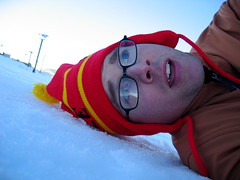How much wood could a woodchuck chuck if a woodchuck could chuck wood? Harry Gina, New York, NY. Well Mr. Gina, you'll be interested to know that the "woodchuck" (a folk etymology of a New England Algonquian word), or "groundhog", is known in the Appalachian Mountains as a "whistle pig" where legend purveys that it can whistle with such a mellifluous melancholy as to induce its enemies into a long, sad slumber. At any rate, to answer your question, IF a woodchuck could chuck wood, it could chuck: 4 pecks, (2,150.42 cubic inches). The woodchuck, dishearteningly, cannot chuck wood. Enjoy the nice weather, Harry!
Saturday, May 06, 2000
Wednesday, May 03, 2000
Why is my napkin transparent after I wipe my face? Dan "G" from New York wants answers. The phenomena that causes your napkin to be capable of transmitting light so that objects or images can be seen as if there were no intervening material, i.e., so fine in texture that it can be seen through, or "sheer" is complex yet extremely common. The machine woven octagonal infrastructure of a paper napkin is *transdensed* when it is moistened by such things as the unctuous remains of Chinese fast food chicken left on your person after a large intake. Transdension causes molecules to be flattened while at the same time uniformly realigned to allow the passage of light. Thanks for contributing to supertectonics!
Monday, May 01, 2000
Are there really such things as ghosts? Pinkus Heinemann of Berlin, MA is suspect. Pinkus, the idea that the spirit of a dead person, especially one believed to appear in bodily likeness to living persons haunts former habitats is heavily flawed, but true. When someone "sees" a ghost they are witnessing a spectral distortion caused by imperfections in the *dimensional grating*. Natural phenomena can cause significant turbulence within the space-time *manifolds* that usually separate the multiple layers of "reality". As a result images and sounds are temporarily broadcast outside of their usual boundaries. Don't be afraid.

